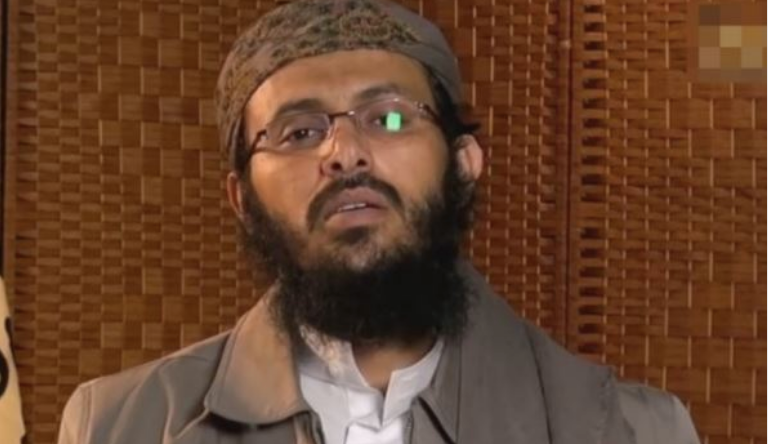On February 6, the White House confirmed that Qasim al-Raymi (or al-Rimi), who repeatedly threatened America as the head of al-Qaeda in the Arabian Peninsula (AQAP), had been killed in a “counterterrorism operation”—meaning a drone strike. The CIA hunted Raymi for years, after successfully hunting down several other senior AQAP figures.
The White House’s statement contains an observation that deserves more attention. Namely, Raymi was not only “a founder and the leader of” AQAP, but also “a deputy” to al-Qaeda’s global leader, Ayman al-Zawahiri. That’s a subtly important description.
It likely means that Raymi was a part of al-Qaeda’s senior management team, which sets policies and provides direction to jihadist groups everywhere from West Africa to South Asia. That is, Raymi’s influence within the jihadist world wasn’t confined to AQAP’s strongholds in Yemen. This is consistent with what we know about Raymi’s predecessor as AQAP head, Nasir al-Wuhayshi, who was killed in a June 2015 drone strike. Wuhayshi was both the overall emir (or leader) of AQAP, and a top deputy to Zawahiri.
But what were Raymi’s exact title and responsibilities within al-Qaeda? We don’t know. Was he in the line of succession to replace the elderly Zawahiri? Presumably, but we can’t say for certain where he was in the pecking order. On which internal al-Qaeda committees and councils did Raymi serve? There are no publicly available answers to these basic questions.
Indeed, more than 18 years after 9/11, and more than 30 years since al-Qaeda’s founding, the U.S. and its allies do not have a consistent, fact-based definition of the group.
That may seem absurd, but it’s true.
Bruce Hoffman, the preeminent terrorism scholar, wrote in 2003 that there was widespread “[d]isagreement over precisely what al-Qaeda is.” It is “remarkable,” Hoffman noted, that “al-Qaeda remains such a poorly understood phenomenon,” as evidenced by the “ways in which it is variously described or perceived.”
That is still the case all these years later.
To be sure, the Office of the Director of National Intelligence (ODNI) offers general descriptions of al-Qaeda in its annual Worldwide Threat Assessments, which are provided to Congress. And there are various snippets of information throughout other official American statements and counterterrorism designations. However, the U.S. government doesn’t provide the public with regular or even infrequent descriptions of al-Qaeda’s hierarchy or structure.
The 9/11 Commission offered a summary of al-Qaeda’s organizational scheme, with a shura (or advisory) council sitting under Osama bin Laden and various committees handling matters related to “sharia” (Islamic law), military programs, finance, foreign purchases (for weapons and the like), and security. But that report was issued in 2004 and the U.S. government hasn’t published regular, unclassified assessments concerning how this structure has evolved since then.
What’s worse, a new paradigm has taken hold, and it’s demonstrably inaccurate. U.S. officials often attempt to draw a firm distinction between “core” al-Qaeda in South Asia and the organization’s “affiliates” elsewhere. This false dichotomy was enshrined during the Obama administration.
For instance, during a 2013 speech, President Obama declared that the “core of al-Qaeda in Afghanistan and Pakistan is on the path to defeat.” Three lines later in the same speech, after downplaying the influence of al-Qaeda’s senior leadership, Obama added: “Instead, what we’ve seen is the emergence of various al-Qaeda affiliates.” He then mentioned several geographic areas where al-Qaeda “affiliates” were present, specifically highlighting the threat posed by AQAP—“the most active in plotting against our homeland.” Although Obama didn’t dismiss AQAP as a threat, he clearly did think of it as a compartmentalized entity. He also portrayed other jihadi outfits as “simply collections of local militias or extremists interested in seizing territory.” This same assessment was the basis for Obama’s flippant description of the Islamic State as the “jayvee” of terrorism.
But as Raymi’s career and the dossiers of other AQAP figures show, there is no clear dividing line between the two. A “core” al-Qaeda member can be stationed in any one of several countries, far afield from Afghanistan and Pakistan. While it is true that many of al-Qaeda’s jihadists are primarily interested in “local” concerns, the false distinction between the group’s “core” and “affiliates” has distorted America’s understanding of the group as a whole.
The situation today is such that beyond a select set of jihadists who are widely known in counterterrorism circles, al-Qaeda itself feels like an amorphous abstraction. This is the case despite abundant evidence showing that al-Qaeda has, against long odds, retained an international organization that is more cohesive than some counterterrorism officials would care to admit.
Consider the career of Ayman al-Zawahiri—the elderly jihadist Raymi served. This terrorist has been a wanted man since the 1980s, when he was briefly imprisoned in Egypt. The Egyptian doctor has been hunted by the U.S. since the mid to late 1990s, if not earlier. Zawahiri led the Egyptian Islamic Jihad (EIJ), a terrorist group that failed to overthrow the Egyptian government and formally merged with Osama bin Laden’s enterprise before 9/11. His EIJ men played key roles in al-Qaeda’s August 1998 U.S. Embassy bombings in Kenya and Tanzania.
With respect to Zawahiri, American counterterrorism analysts are fond of repeating a shallow talking point. It is often said that he lacks the charisma of Osama bin Laden, so he is not an effective leader. It is certainly true that some of Zawahiri’s long-winded lectures have been boring diatribes—harangues that are unlikely to inspire many of the youth. Then again, Zawahiri isn’t attempting to win the affection of the hotheads drawn to the Islamic State’s snuff films. His longer sermons are usually intended to serve as rebuttals to the many Islamic scholars with better credentials who reject al-Qaeda’s program. An al-Qaeda editor has also shortened some of Zawahiri’s presentations into more digestible clips.
Zawahiri has also faced significant leadership crises—namely, the rise of the Islamic State in 2013 and 2014. Zawahiri was a vocal defender of the group’s predecessor, the Islamic State of Iraq, but Abu Bakr al-Baghdadi and his men rebelled against his authority and encouraged al-Qaeda’s rank-and-file around the globe to defect to the self-declared caliphate. The jihad in Syria has unleashed one management nightmare after another for Zawahiri in the years since, even among the al-Qaeda loyalists who rejected Baghdadi’s delusions of grandeur.
Despite these and many other problems, Zawahiri is alive, which in and of itself is something of a feat. After all, his longtime comrade-in-arms, Osama bin Laden, has been dead for nearly nine years. Zawahiri’s main jihadist rival, Abu Bakr al-Baghdadi, succumbed to America’s counterterrorism campaign a little more than five years after becoming enemy No. 1.
Do you think you could survive decades on the run, being hunted by the U.S. and its allies, while overseeing a prolific terrorist and insurgency organization? Seems unlikely.
Zawahiri has done more than survive. On one high-profile occasion, he turned the tables against the Americans who were hunting him. On Dec. 30, 2009, a Jordanian doctor named Humam Khalil al-Balawi blew himself up inside Camp Chapman in Khost, Afghanistan. The CIA, which has successfully tracked down dozens of high-profile al-Qaeda operatives, believed that Balawi could lead the agency’s women and men to Zawahiri’s doorstep. Instead, Balawi killed seven CIA officers and two others in his suicide bomb blast.
Today, a decade after Balawi’s treachery and despite the many problems caused by the Islamic State, as well as countless other difficulties, Zawahiri still commands the loyalty of thousands—at least thousands—of fighters around the globe. For al-Qaeda diehards, Zawahiri is the “Wise Man of the Ummah,” a prescient thinker who predicted the collapse of Baghdadi’s territorial caliphate and has taken a long view of the jihadists’ war against the West and other foes.
Yet, you will search in vain for a consistent framework, based on firm evidence, for understanding Zawahiri’s al-Qaeda.
We know that men such as Raymi are members of al-Qaeda’s senior management. We know, too, that other al-Qaeda veterans continue to manage active portfolios as well.
Decades after they first joined the jihad, EIJ legacy terrorists such as Saif al-Adel and Abdullah Ahmed Abdullah (a.k.a. Abu Muhammad Al-Masri), both of whom are wanted for their roles in the aforementioned 1998 embassy bombings, are directly assisting Zawahiri from their safe haven inside Iran. This observation is not part of some conspiracy to start a regime-change war with Iran, as some defenders of the Iranian government allege, but instead a basic observation. In 2018, for instance, a panel of United Nations Security Council experts reported that Adel and Abdullah had “grown more prominent” in al-Qaeda’s global network, allowing Zawahiri to project “his authority more effectively than he could previously.” From 2011 to 2016, the Obama administration’s Treasury and State Departments repeatedly explained that the Iranian regime has an “agreement” with al-Qaeda, allowing the “core facilitation pipeline” for Zawahiri’s network to exist inside Iran. This formerly “secret deal” persisted despite the fact that Iran and al-Qaeda are at odds with one another in significant ways. The two are at loggerheads in Syria and Yemen, for example.
We can identify other al-Qaeda bigwigs in Afghanistan, Pakistan, Syria, and Yemen, as well as throughout Africa. Still, the U.S. government hasn’t explained how they all fit together, besides some loose connection between the “core” and the “affiliates.”
Here’s another example of how the dearth of information hurts the public’s understanding. In September of last year, the White House announced the death of Hamza bin Laden—a big name in the counterterrorism world due to both his pedigree and prominent speaking role on behalf of al-Qaeda. But the U.S. hasn’t explained what position the junior bin Laden held inside al-Qaeda, or what he was actually doing, beyond issuing regular messages. The White House argued that Hamza’s removal “undermines important operational activities” within al-Qaeda, without specifying what those activities entailed. Osama bin Laden’s heir was also “responsible for planning and dealing with various terrorist groups,” the Trump administration said. Those other groups weren’t named. It is likely the Taliban, including the notorious Haqqanis, were among them—even as the State Department seeks counterterrorism assurances from the Taliban’s political team in Doha.
Which leads to another related point. Al-Qaeda has been able to regenerate parts of its organization by leveraging its relationships with other jihadist groups, as well as some Islamist parties. In Yemen, Qasim al-Raymi’s AQAP draws recruits and other support from the Islamist Islah party, which was cofounded by one of Osama bin Laden’s earliest allies, a U.S.-designated terrorist named Sheikh Abdul Majid al-Zindani. There has been no thorough, public accounting of al-Qaeda’s many relationships in some years, if there ever was one. But this helps to explain why al-Qaeda is still very much alive, despite two decades of “endless war.”
None of this is an argument for expanding the U.S. military’s mission. The days of large-scale, U.S. interventions to fight jihadists are over, or at least coming to an end. But America still has an interest in disrupting the operations of anti-American terrorist organizations, whether it be through direct counterterrorism operations such as the airstrike that killed Raymi, or by supporting local allies, some of whom are already carrying out the bulk of the fighting.
Regardless of one’s policy preferences, America’s actions should be rooted in a comprehensive, holistic accounting of al-Qaeda, as well as the Islamic State. It’s 2020, and the U.S. still doesn’t have one.






Please note that we at The Dispatch hold ourselves, our work, and our commenters to a higher standard than other places on the internet. We welcome comments that foster genuine debate or discussion—including comments critical of us or our work—but responses that include ad hominem attacks on fellow Dispatch members or are intended to stoke fear and anger may be moderated.
With your membership, you only have the ability to comment on The Morning Dispatch articles. Consider upgrading to join the conversation everywhere.